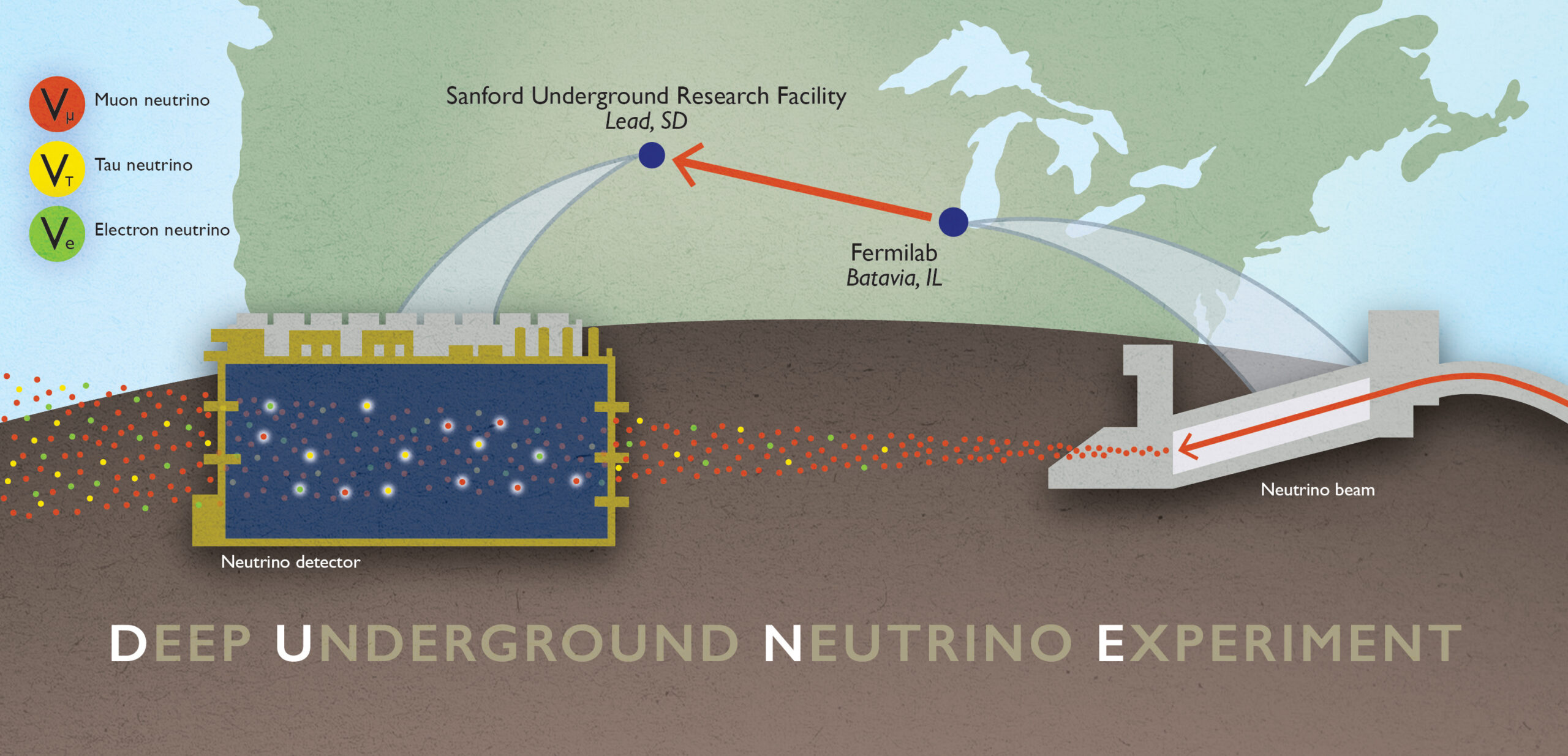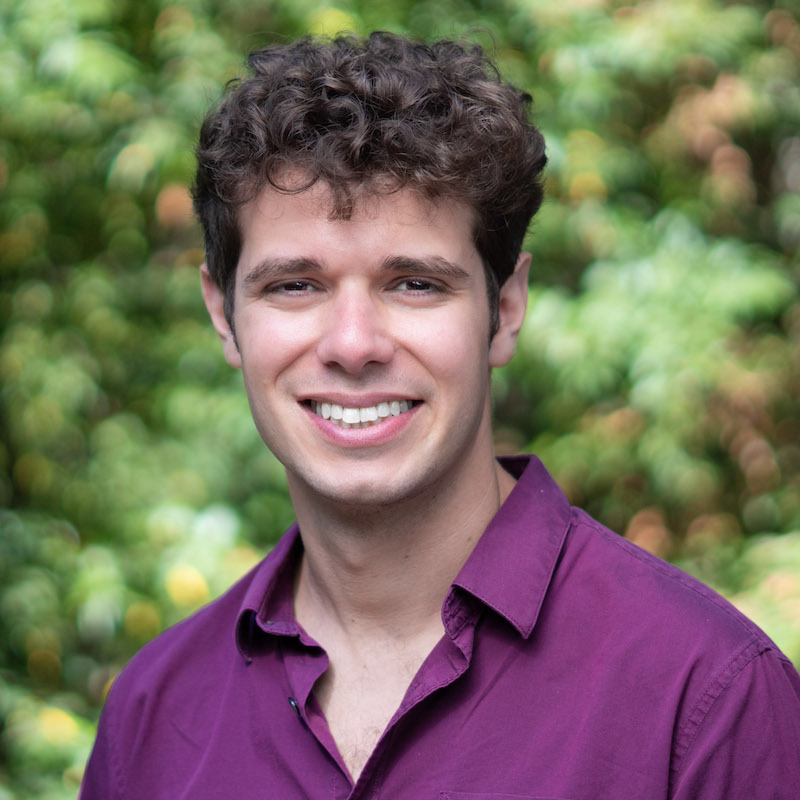Mining for Answers
A mile underneath the Black Hills of South Dakota, physicists have scooped out a giant hole. What they put there may finally tell us why matter exists in the universe.

In its heyday, the miners would have would have filled and emptied the elevator’s garage-sized interior with loads of glittering ore several times a day. Now it mostly carries bedrock debris, hoisted up the mile-long shaft to clear the ever-expanding cavern below.
This empty, underground cave cost hundreds of millions of taxpayer dollars just to dynamite into existence. Soon, it will house the listening end of an 800-mile tin can telephone. Once the metal ear inside it is constructed, it will try to pick up a secret message about the Big Bang and the origin of matter, whispered through three states worth of solid bedrock from the other tin can outside Chicago.
The faint message, carried by an intense beam of elusive particles called neutrinos, may finally explain a tiny imbalance at the beginning of the universe that built everything we see today. It could answer a question so heady and fundamental that philosopher Martin Heidegger used it to introduce his Introduction to Metaphysics: “Why are there beings at all, instead of nothing?”
Unless the tin can is never built, and the cavern remains just an expensive, government-contracted hole in the ground.
DUNE is the formal name for this tin-can-telephone experiment. Its swelling cost and slipping schedule led critics to call for its cancellation by the Department of Energy. But the project’s expensive underground dwelling is finally excavated, and the U.S. physics community has successfully lobbied to give the project one last chance. Without DUNE, the U.S. will likely fall irrevocably behind in the international race to understand neutrinos, the most mysterious particle known. At stake are a projected $3 billion taxpayer investment, decades of design and construction work, and the careers of more than 1,000 physicists whose livelihoods depend on the gargantuan undertaking’s success.
Nature’s ghosts
Neutrinos have restored balance before. Wolfgang Pauli invented them in the tks to explain a curious phenomenon. Physicists had observed than when they split an atom, its two parts would fly off at odd, oblique angles, rather than flying away in equal and opposite directions, as predicted from Newton’s laws of motion. Pauli hypothesized that this happened because splitting an atom created three, not two, fragments: two observable ones, and a third, unseen, tiny, ghostly bullet that must be whizzing off in a third direction, as fast as light but ethereal as a specter, to make everything balanced.
When neutrinos were finally actually measured and studied in the 1960’s, they raised more questions than they answered.
Physicist Ray Davis wanted to be first to measure the steadiest neutrino beam that nature provides: the sun’s rays. The thermonuclear explosions in the sun that light up our world also beam out an invisible glow of neutrinos in all directions. The best place to look for neutrinos from the sun is actually underground, since, unlike other particles that bombard us from space, only neutrinos can pass through the Earth’s crust. So, like other physicists all over the world, Davis sought an underground location where he could build a neutrino detector.
He chose a gold mine in the Black Hills of South Dakota that had been active since 1876, and named his “Homestake experiment” after the joint-stock mining company that owned the mine.
Davis’s experiment was about to discover more than he bargained for, putting particle physics on the path to a much grander vision for Homestake.
The matter imbalance
Particle physicists have spent the past century trying to recreate the Big Bang in a lab to understand how the universe’s matter was created. But in every experiment, any matter the researchers created was accompanied by an equal measure of a substance called antimatter.
Each fundamental particle has an antimatter doppelganger, its nemesis. These antimatter particles, or antiparticles, essentially cancel matter out. Whenever a particle and its antiparticle meet, they annihilate one another, leaving neither matter nor antimatter behind. It’s like how when you add one and negative one together, you end up with nothing. Every time physicists simulate the Big Bang, it turns out the same way: It makes lots of particles, but it also makes an antiparticle for each and every one, and when the smoke clears, nothing is left.
But the actual Big Bang transgressed this seemingly inviolable symmetry, or else our whole world would have the same nothing left. It created slightly more matter than antimatter. Unimaginable quantities of both came into being and then annihilated each other, but when the dust settled there was a miniscule excess of matter left over. That’s us, and everything else in our universe today.
Every particle physicists study fails to explain how the universe pulled off this magic trick of genesis. But neutrinos might be different.
There are three “flavors” of neutrino – completely distinct particles that share only their ghostliness and speed. In 1968, Ray Davis reported that a huge portion of the sun’s neutrino gleam was disappearing before it got to Earth.
He was wrong. The neutrinos weren’t disappearing – they were changing. While every other particle has an immutable identity, it turns out, neutrinos shapeshift from one flavor to another as they move through space.
“It’s as stark as if you turned into your grandmother as you walked to the kitchen, and then turned back into yourself and you walked back to your room. That’s essentially what neutrinos do” says Bryan Ramson, a neutrino physicist at Fermilab working on DUNE, of this “long-term, long-distance quantum effect.” Davis had built his detector to measure only the flavor the sun could make, so the rest were slipping right by.
To Ramson and his DUNE colleagues, what Ray Davis once called “the solar neutrino problem” is known as neutrino oscillation, and it might hold the key to the Big Bang’s imbalance.
“That’s essentially what we’re trying to figure out between neutrinos and anti-neutrinos, is whether there is a different effect because of their anti-particle nature,” Ramson says. “If there is a different effect, this gives us room to fit in this matter/anti-matter asymmetry at the beginning of the universe.”
More than DUNE’s physical scale and noteworthy price tag, it’s this existential goal of explaining matter’s origins that places it among the most ambitious experimental endeavors in humankind’s history. Heidegger, who romanticized the Middle Ages “when all scientists were philosophers”, would likely admire Ramson and his colleagues.
A camel through the needle’s eye
The elevator shaft Ray Davis once used to access his owned tank of buried liquid presents a unique challenge to DUNE’s designers, reminiscent of a different kind of ghost.
In Chinese Buddhism, a “hungry ghost” is a creature you don’t want to be reborn as—a symbol of constant suffering, firmly below a cockroach on the karmic ladder, and just above hell. As the name suggests, they’re perpetually starving to fill their vast, vacant bellies. But a long, narrow esophagus prevents them from getting anything substantial enough down.
DUNE’s scientists are similarly tasked with the miserable work of filling an airport-sized cavern with a Godzilla-sized machine, through a mile-long 19-by-14-foot shaft. That means no single piece of the structure can be bigger than 19-by-14 feet. But the cavern had to be this large to resolve neutrinos’ mysteries.
To measure neutrinos, you have to stop them. Though the fast-flying ghosts pass through almost every atom of matter like it isn’t there, once in a very, very long while, they become corporeal and smash into one. When this happens to an atom that happens to be inside a neutrino detector, it makes a flash of light and a zap of electricity that the detector can measure, teaching physicists one iota more about the particles.
To figure out if neutrinos and antineutrinos dance differently, the physicists have to get this to happen billions of times inside the mine. So they need lots of atoms to hit their detectors, so they can trap as many neutrinos as possible.
That’s why they need to build a stadium, and none of the lego bricks they construct it from can be broader than that tiny shaft. It makes some wonder if this is really the only way to figure out what neutrinos are all about.
The P5 report
The grand vision of a neutrino beam from Fermilab to Homestake took over American particle physics in 2014.
After decades of presenting a diverse suite of opinions to congresspeople still traumatized from high school physics, the particle community organized the “P5 process”. Scientific leaders would gather and argue until they coalesced around a concise, comprehensive set of priorities for the next ten years, to guide Congress in the budgetary process.
In 2014, the P5 committee sent a clear message – the U.S. needed to take a big swing at neutrinos, and DUNE was it. It was projected to cost was $1.7 billion, though Project Director Chris Mossey is frustrated when people refer to this as DUNE’s ‘initial budget’.
“There was no budget. Somebody said ‘this is what we think is going to cost’, but there was no budget,” he says. The goal P5 laid out was for DUNE to be operational by 2026, and produce an initial answer to the matter/anti-matter question by 2035.
Other countries, including China and Japan, had already begun this quest. In Japan, a neutrino beam from a nuclear reactor in Tokai to a water-filled particle detector under a mountain in Kamioka was making measurements. It couldn’t produce enough data to explain what tipped the scales toward matter after the Big Bang, but proved that a bigger version likely could. Japan planned to build a nearly identical but much larger detector under another mountain five miles from the first to study the same beam. The “Hyper-K” experiment, a simple step-up for Japan compared to DUNE’s unprecedented swing, hoped to answer the matter question first.
Mossey says the DUNE team spent years considering smaller, sleeker versions of the project to reduce the price tag and construction time. “And at the end, the decision was ‘No, we have to do this right.’ We have to achieve the full vision, and this is what it’s going to cost.”
But as the U.S. government’s approval process for the project progressed, its projected cost nearly doubled to reach a staggering $3 billion by 2020.
The excavation schedule also slipped about five years, as the mine turned out to need a significant infrastructure upgrade to support the experiment. With the project’s rising costs and elongating timeline, DUNE’s critics got louder.
Meanwhile, Hyper-K planned to be running by the mid-2020s, and Japan has a stronger track record of keeping particle physics projects on schedule than does the United States. If neutrinos turn out to straightforwardly explain the universe’s imbalance, Japanese researchers aim to crack the case within a few years of Hyper-K’s planned start in 2027.
In the last few years, a spate of mishaps at Fermilab, where the neutrino beam’s construction was underway, fanned the flames of criticism. The U.S. Department of Energy, which manages Fermilab, gave the lab a failing performance grade and considering changes to its leadership and management, which remain up in the air today. A series of articles in the scientific media questioned the lab’s, and DUNE’s, integrity. With the P5 committee reconvening in 2023 to decide the next decade’s priorities, some wondered whether DUNE would be on the chopping block.
“This press, as it came out, was something I had to really think about as I was deciding what I wanted to do with the rest of my life,” DUNE scientist Bryan Ramson says. “I’ve given up extremely lucrative careers elsewhere to follow my interests. If the government is going to cede American particle physics superiority, then I would have essentially made the wrong bet.”
If DUNE were cancelled, Ramson says, “I think what it would signal to the world is that America does not want to lead particle physics anymore.”
New decade, new beginning
On December 8th, the 2023 P5 committee vocally re-affirmed DUNE’s central importance to the country’s particle physics future.
“We felt the responsibility. It was a daunting, scary task,” said Yale University physicist Karsten Heeger, who was deputy chair of the panel. “There were many days when the committee was in a hotel room for many hours and we talked about things late into the night. But everyone felt like we wanted to work together to create the best possible outcome for the field.”
In the end, Heeger says, the scientific were too high not to endorse the project. “This is a real opportunity for the U.S. to lead the world,” he said, “and to become the center of neutrino physics for the coming decades.”
“I couldn’t be more pleased with the outcome” says Fermilab’s director, Lia Merminga. She admits that Fermilab has faced real challenges in the recent year, but also says “we’ve almost put it behind us.”
“When P5 came out, it really was a big deal. I think everybody was excited,” Ramson says.
With the community symbolically rallied behind it once more, DUNE hit another critical milestone: the final blast of dynamite completed the underground cavern on February 2nd.
“We are at a turning point, now that excavation is complete,” says Fermilab scientist Flavio Cavanna, excited that it’s the scientists’ turn to drive the schedule forward. “Now we as physicists have to play the main role, so the ball is in our court.”
Fermilab’s neutrino beam team has already helped undo some of the schedule slippage. Scientists in charge of the upgrade found a way to simplify things and get more neutrinos pumping out of Fermilab earlier than expected. This may not erase all of the delays, but if things go well, DUNE could achieve its minimum original goal from 2014 of “120 kiloton-megawatt-years” of data by 2035, enough to provide that initial answer.
Karsten Heeger said these improved prospects played a role in P5’s decision. “The community has developed a much better understanding of what it takes to do the project,” he said, “and the recent revisions to the project reflect this.”
Will this experiment finally render neutrinos a known quantity, keep America relevant in fundamental physics, and tell us why we came to be here? Ramson is confident that DUNE is the right choice.
“DUNE will be essentially the perfect long-baseline neutrino oscillation experiment,” he says. “If you gave me a trillion dollar budget and all the time in the world, it’s hard to see how we would do better.”
© 2024 Joseph Howlett / UC Santa Cruz Science Communication Program
A version of this story was first published in The New York Times.
https://www.nytimes.com/2024/08/30/science/astrophysics-dune-neutrinos.html

Joseph Howlett
Author
Internships: SLAC, The San Francisco Chronicle (Contract Writer), Quanta
I ended up a scientist because I asked too many questions. My annoyed high school chemistry teacher started answering my questions with, “You’ll learn that in physics.” Then my physics teacher started saying, “You’ll learn that in college,” where, eventually, people told me, “You’ll learn that in grad school.”
Now I have a Ph.D. in physics and no satisfying answers, which is actually more mind-boggling than anything I learned along the way. I don’t think all that time and education was a waste; I just want to use it to engage with the vast unknown rather than to chip away for a lifetime at one little corner of it. I want to find and tell stories that answer people’s questions about how the world works honestly rather than deflecting, even if the answer is usually, “We don’t know.”

Haley Grunloh
Illustrator
Haley Grunloh is an illustrator from New Haven, CT. She has always had a fascination with animals, and drawing them has been a good excuse to study them closely. She has a particular interest in the less ‘charismatic’ species that can be easily overlooked. Aside from realistic natural history illustration, she also has a great love for the art of children’s books, informed by her background working in a public library. In her work she aims to use humor, storytelling, and fun imagery to spark curiosity about nature and promote science literacy.